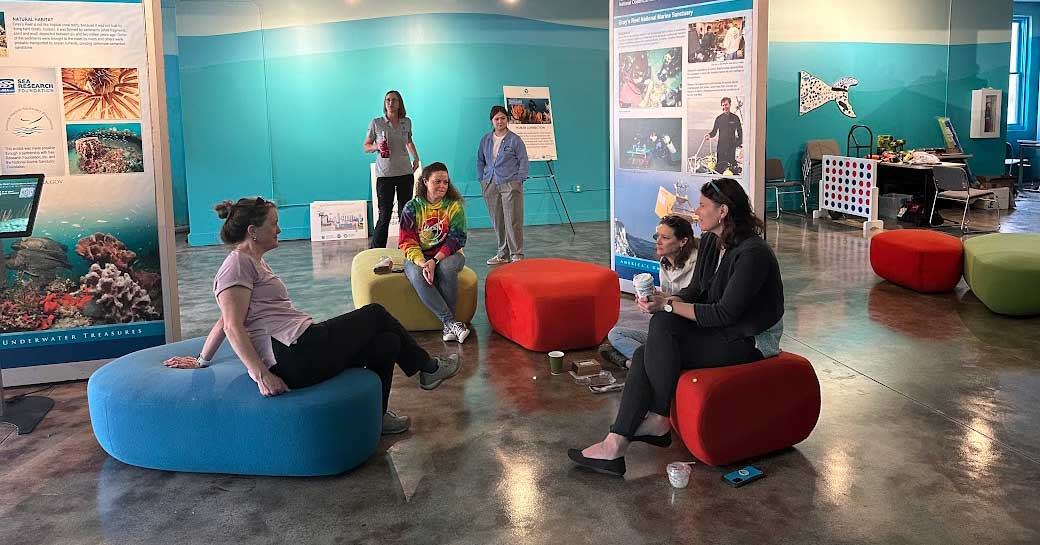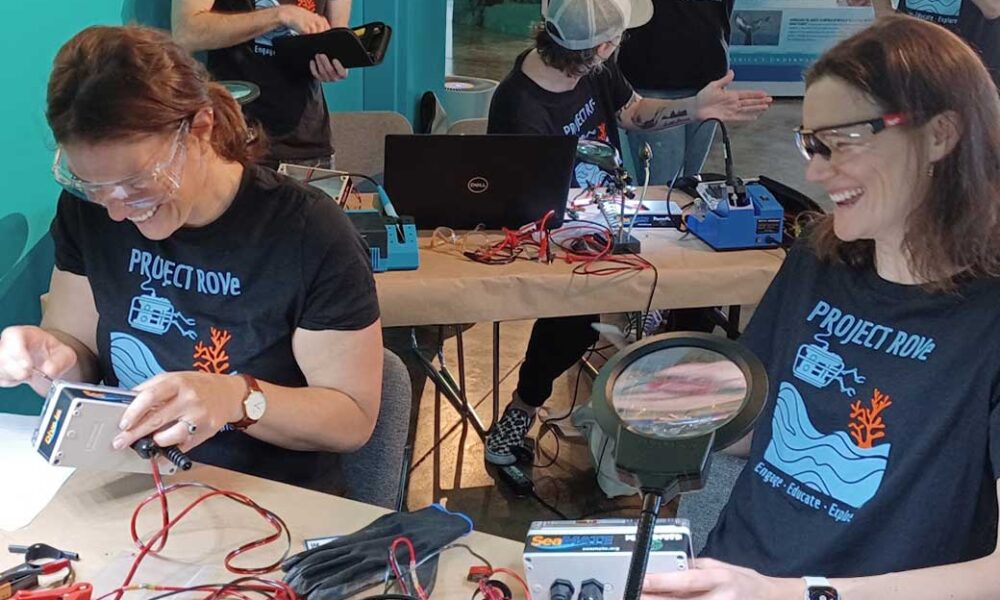
Building Connections and Making Waves in Savannah
By Andrea Schmuttermair, TASAA ROV Education Coordinator
The thing I love most about the Teacher at Sea Alumni Association (TASAA) is the people, the amazing network of educators who all have one thing in common–we are explorers. Each one of us shares a passion for the ocean and our planet, and equally, the opportunity to bring the world into our classrooms and share it with our students. When opportunities arise to be at the cutting edge, we jump at them.
It is no surprise that when the second Project ROVe cohort was invited to come together for an ROV building workshop, ten TASA jumped at the opportunity to join me in Savannah, Georgia to tackle this learning together.

Individually, we are one drop. Together, we are an ocean.
Ryūnosuke Akutagawa
Arriving at our host location, Gray’s Reef National Marine Sanctuary’s new Ocean Discovery Center (ODC), participants found a space filled with colorful walls, ocean-themed posters, and NOAA paraphernalia. This environment reminded us of our common bond, the NOAA Teacher at Sea Program. Participants sat on “coral polyp” stools while getting to know one another over breakfast, and tables were set with all the tools and materials they would need for the workshop. They excitedly looked through the Gray’s Reef canvas bags at their workstations to discover all the supplies they would need to build their ROVs.


Eager learners soaked in information about the Sanctuary presented by Jody Patterson, Chapter Director of Gray’s Reef National Marine Sanctuary Foundation. Maddie Monroe, a University of Georgia Sea Grant Fellow, shared information about current research projects in the Sanctuary to provide context for the importance of bringing marine technology to classroom.
We learned about the Sanctuary Soundscape Monitoring Project (SanctSound) and the value of collecting underwater sounds using a variety of instruments. Jody and Maddie presented live data from Gray’s Reef buoys, and we discussed how this data could be shared with students. Maddie also shared the variety of technology that is being used to learn about Gray’s Reef (and other Sanctuaries), including ROVs, Go-BGC floats, autonomous vehicles, and acoustic sensors.


After the stage was set for the importance of using marine technology to research critical ocean habitat, alumni spent the remainder of the weekend learning new skills such as soldering and creating complex circuits as they constructed SeaMate Pufferfish ROVs. They shared ideas on frame design and helped one another troubleshoot control boxes. They were challenged to learn something new, something perhaps they didn’t have the confidence to tackle solo. Throughout the process, we laughed together, got frustrated together, and walked away with ever-growing relationships.
What came out of the weekend wasn’t just the knowledge of how to construct an ROV, but a collaborative cohort of empowered and reenergized educators who are ready to share their new skills and learning with their students and who are not afraid to ask each other for help along the way.
What is Project ROVe?
 Project ROVe (Remotely Operated Vehicles for Educators) gives educators the opportunity to ENGAGE with other alumni and experts in the field, EDUCATE themselves in a cutting-edge STEM topic, and confidently develop curriculum for their students to EXPLORE their environment through marine technology.
Project ROVe (Remotely Operated Vehicles for Educators) gives educators the opportunity to ENGAGE with other alumni and experts in the field, EDUCATE themselves in a cutting-edge STEM topic, and confidently develop curriculum for their students to EXPLORE their environment through marine technology.
Project ROVe consists of a series of marine technology-focused professional development courses for educators and supports them through integrating related concepts with their students. There are currently two course offerings. Project ROVe: Introduction to ROVs is an online course where educators learn about ROVs and ROV concepts through activities, readings, discussions, and live guest speakers. Those who complete the course are eligible to take the Project ROVe: Design and Build course—an in-person, ROV-building workshop. The courses culminate in educators creating plans for integrating marine technology into their curriculum.
 Andrea Schmuttermair sailed on NOAA Ship Oregon II for a groundfish survey in 2012 and again in 2015 an alum on NOAA Ship Oscar Dyson for a pollock survey. In 2021, she joined the Teacher at Sea Alumni Association to pilot a new program—the Teacher at Sea Alumni Association NOAA Fellowship. After Andrea’s fellowship concluded, she stayed on with the Alumni Association to continue engaging alumni in remotely operated vehicle (ROV) professional development as part of the Project ROVe program she created.
Andrea Schmuttermair sailed on NOAA Ship Oregon II for a groundfish survey in 2012 and again in 2015 an alum on NOAA Ship Oscar Dyson for a pollock survey. In 2021, she joined the Teacher at Sea Alumni Association to pilot a new program—the Teacher at Sea Alumni Association NOAA Fellowship. After Andrea’s fellowship concluded, she stayed on with the Alumni Association to continue engaging alumni in remotely operated vehicle (ROV) professional development as part of the Project ROVe program she created.




